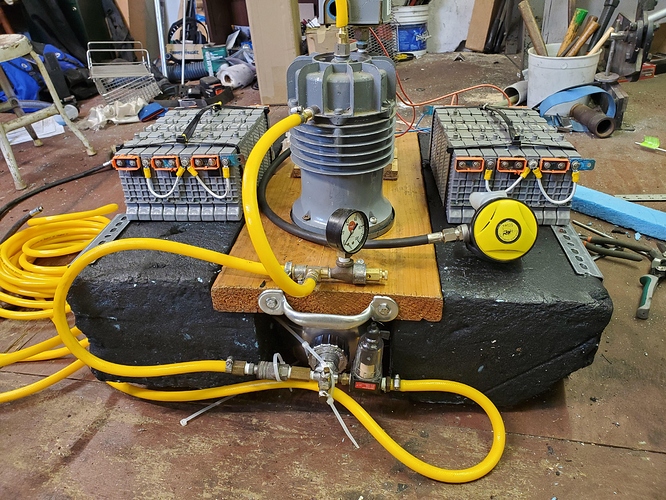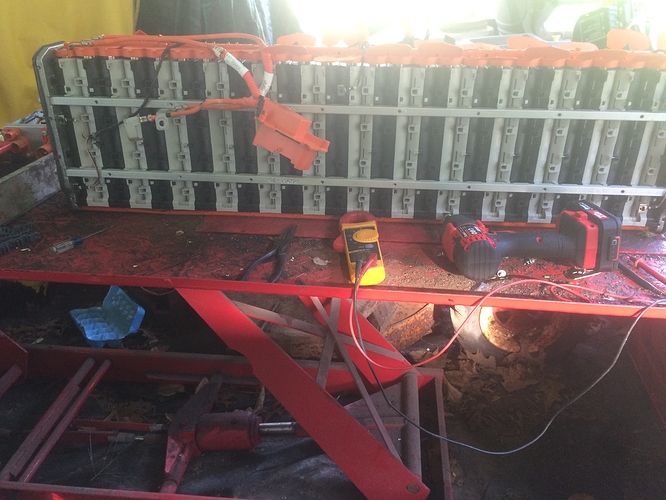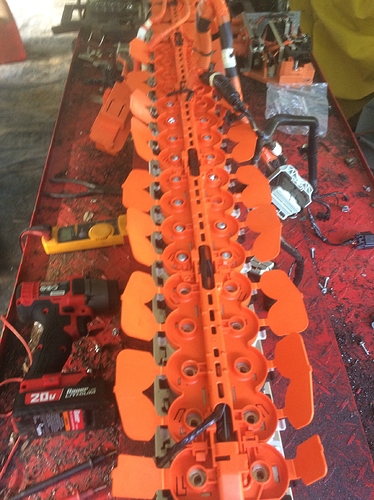I would just buy the led strip lights that are 12 volt DC by design. I used them in my chicken coop a 5 meter long strip is running in a 2 amp 12 volt DC supply with no problem at all and it makes a ton of light in there.
I think it might be hard to find 12 volt bulbs that are designed specifically for growing plants. If I recall correctly, white LED lights do not have a good spectrum for plants, which is why the growbulbs are that weird pink color. Plants are not using the middle part of the spectrum, which is why they appear so nice and green.
There is nothing inherently wrong with 12v, and it is very ubiquitous. 24v is not far behind though. As long as you have enough room to put the inverter and charger right next to the batteries, you should be fine. At 12v you are looking at pulling 83 amps and probably charging at up to 200A. If you have a bunch of 2/0 cable laying around, and the lugs on the inverter/charger will accept it, then it wont really matter. Just make sure any long cable runs are carrying 120 AC, and everything will work out fine.
https://commonbunny.com/products/grow-strip
That was the first hit on a google search. I actually bought some led grow lights for my garden plants this year. The lights worked but I didn’t use enough fertilizer so the plants died during the transplant. But they had really nice color from the grow lights.
right as i was saying you can get leds in any format you want they are acually small arc lamps in a special gas. I made a home made led light to show my kids how they worked but they were 1000 watts of power when i turned them on they lit up an area of 1 1/2 miles brighter than day that was 35 to 38 years ago my oldest was 12n at the time he is now 45. I made the unitl for him to take to a science fair . he wasnt allowed to use it to much UV radiation they said. but with a set of binoculars we saw a fox stop and look at us at the far tree line. the led are DC only the arc is very short somthg like a sparkplug gap and very small current so they will last 10,000 hrs. the power going through the gas causes it to glow that is how they work very simple ther is more to it but not much. there is formulas for figuring out the power required and the resisters take the screw in led light bulbs and leave the screw part on change the resister to the voltage you want then set up a lighting system to that voltage I was looking at making lights for sale for 12 volts but have other more important things in the fire. a few years ago I had a 54 ft sail boat and i used 12 volt floresents that didnt use a ballest it used a 400 cycle osilater It was about the size of a small match box it lit the light some what like a led by putting power in to ionize the gas in the tube it produced UV rays that excited the floresence on the tub. that is how a floresent tube works the light from the gas isnt what you see with out the coating inside the tube you only have black light.58 years ago i use to tell people about tickling the gas with electrons to make the gas laugh and produce light now yous see it but people still dont understand.
oh i forgot to say 1 deep cycle 12 volt battery charged in may then in august kept the lights on every weekend till november only 4 lights but they never droped below 10 volts that was the cut of point for the oscilater
Sounds like you made HIDs (high intensity discharge) not LED (light emitting diode). That sounds like great fun.
I was thinking carbon arc. When I was in elementary school, I bought a friend’s carbon arc school project, took it home and blew out a few fuses.
it was HID but i have always thought of them as the same. neither has high pressure gas. they both have a voltage discharge into a gas atmosphere the only difference is the high current burns the electrodes in a 20 to 45 minute window but a lot of light white light. also a lot of UV light. it was to show the kids how they worked. i have also built carbon arc lights the carbons are durty. they will blacken the reflecter in a few minutes as they are not enclosed in a tube. they both used a resister as well the resister would only allow a thousand watts. I know i over powered them but i didnt whant them to last only show the kids what they could do as they didnt beleive me when i told them how bright they could be. I am afraid my children have seen a lot of things in there childhood that most poeple havent seen in there life time
Sorry to jump off topic, but this is interesting. Can you provide a description/ pics? I’ve been daydreaming about such a system for too long already.
You need a heater if you are going for the yukon gold. 
Picked this up today, Ford Fusion battery. For a 48v system what would be best? 50v or 60v my inverter high alarm is 58v. I think I can split the cells and get 55v. If I go with 60v can I charge at 55-57v with out hurting the battery?
morningWhat model year did the battery come from? Sounds like the first gen (2009-2012) used a NiMH battery, while the current second gen (2013-present) uses Lithium ion.
Depending on what chemistry you have, you will either have 1.2v/cell for the NiMH, or something like 3.8v/cell for lithium - depending a little bit on what type it is. Both NiMH and Li-Ion batteries have a narrower voltage range than lead acids, so the voltage difference from fully charged to empty will be small. It should be possible to re-configure the cells to make it work. If it is needed, you can always terminate your charge at less than full voltage, but you will sacrifice some capacity by doing that. Neither chemistry should be harmed by under-charging. Lithiums do not really like being charged to 100% anyway - and this brings up another important point - fire.
If you do indeed have a lithium battery, you are going to seriously want to consider a battery management system. Basically if you try and charge a lithium cell that is too empty, or too full, it can burst into flames. That will light the cells next to it. There is no practical way to put out a battery fire once it gets going, so it will burn down whatever it is housed in. The BMS will need to monitor each cell voltage and shut down the charger if any of the cells go outside the safe range. It can also balance the cells by bleeding some energy off the ones with the highest voltage. There are several manufacturers that make BMS systems for EV conversions, but they can run upwards of a grand. There are probably cheaper options, but they will involve a lot more knowledge of electronics.
I am super excited to see how this project goes - I am probably going to try something similar myself at some point.
I think this was out of a 2012, it did have bms wiring, and temp. monitors. So don’t know for sure what chemistry it is. Each cell is 5vx2 for 10v packs. The easiest to divide is 60v if I can do that I can leave it in the nice compact design. I was hoping it was the ones with the square cells with studs, but it’s not.
The fire risk really can’t be over stated. In Australia they passed zoning that lithium ion batteries must be stored in a separate building from the home. I think it requires a metal building but I am not positive. I was watching some videos about people there setting up an off grid system about a year ago when I stumbled across someone explaining that the zoning requirements would make it impossible to put a Tesla powerwall on the side of your house or inside it like Tesla is doing in the USA. Make you also wonder about attached or basement garages with EV. Not that conventional gas cars are all that good inside your living space. But it is common enough in the places where you have snow.
I am setting everything in an out building 30feet from the house, that’s batts, inverter, controllers and all, only wires running to the house.
Schneider designs there inverters to work with 60 volts DC. I know the midnight solar charge controllers will also work with that voltage. Both are also able to be programmed for different charging curves to support lithium ion batteries and other chemistries. I would say the biggest limiting factor on how you configure the batteries will be the hardware you choose to attach to them. Not to state the obvious so much as to say yes it can definitely be done at 60 volts if you use the correct controller off the shelf.
I have midnite kid controllers
Al, Sounds like yours are NiMH batteries (about 1.25 Volt building blocks), because of the 5V, 10V. Lithium cells would be about 3.5 Volts blocks/ intervals. 7.2V-ish, 11V- ish, etc. I like NiMH batteries. I think they are friendlier to re-use for other projects. Just my opinion.  Lithium batteries have the most capacity for their size / weight: hence their current dominant use in portable equipment, vehicles, and model aircraft. The “catch on fire” danger is real.
Lithium batteries have the most capacity for their size / weight: hence their current dominant use in portable equipment, vehicles, and model aircraft. The “catch on fire” danger is real.
I wish more people would realize that what works good one application might not in all applications. I agree that other batteries that are not as light for the same power storage are better for stationary storage. I don’t care how heavy batteries are that just sit somewhere on my property and never move.


